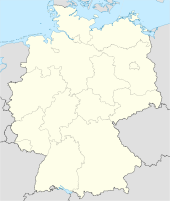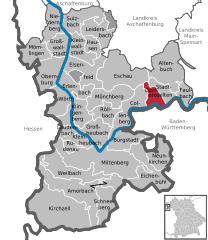- Dorfprozelten
-
Dorfprozelten 
Coordinates 49°47′N 9°23′E / 49.78333°N 9.38333°ECoordinates: 49°47′N 9°23′E / 49.78333°N 9.38333°E Administration Country Germany State Bavaria Admin. region Lower Franconia District Miltenberg Mayor Karl Heinrich Glock (SPD) Basic statistics Area 10.39 km2 (4.01 sq mi) Elevation 141 m (463 ft) Population 1,797 (31 December 2010)[1] - Density 173 /km2 (448 /sq mi) Other information Time zone CET/CEST (UTC+1/+2) Licence plate MIL Postal code 97904 Area code 09392 Website www.dorfprozelten.de Dorfprozelten is a community in the Miltenberg district in the Regierungsbezirk of Lower Franconia (Unterfranken) in Bavaria, Germany and one of the oldest settlements on the Lower Main.
Contents
Geography
Location
Dorfprozelten lies in the Bavarian Lower Main (Bayerischer Untermain) Region
The community has only the Gemarkung (traditional rural cadastral area) of Dorfprozelten.
History
In 1012, Dorfprozelten had its first documentary mention under the name Brotselden or Bradselden. About the name’s origin there are various explanations.
This place in the Archbishopric of Mainz became, in line with the 1803 Reichsdeputationshauptschluss a part of Prince Primate von Dalberg’s newly formed Principality of Aschaffenburg, with which it passed in 1814 (by this time it had become a department of the Grand Duchy of Frankfurt) to Bavaria. In the course of administrative reform in Bavaria, the current community came into being with the Gemeindeedikt (“Municipal Edict”) of 1818.
The community was until the 1970s home to a great sandstone industry. Dorfprozelten stonemasons took part in building, among other projects, the Hermitage in Saint Petersburg, Mainz Cathedral and the Reichstag. Sandstone quarrying also fostered shipping, which for a time made Dorfprozelten Germany’s inland port village. Today Dorfprozelten is home to various branches of industry. Among others, a big car supplier has settled here. On the slopes of the Main, with the Dorfprozeltener Predigtstuhl vineyard, an excellent Franconian wine is raised.
Population development
Within town limits, 1,627 inhabitants were counted in 1970, 1,741 in 1987 and in 2000 1,972.
Politics
The mayor is Dietmar Wolz (Freie Wähler).
Municipal taxes in 1999 amounted to €987,000 (converted), of which net business taxes amounted to €123,000.
Coat of arms
The community’s arms might be described thus: Per fess gules a wheel spoked of six argent and argent a cross sable, a base wavy of three azure.
The black cross on a silver background is the coat of arms once borne by the Teutonic Knights, who are known to have been in the municipal area about 1260. About 1319 or 1320, the Knights acquired Prozelten Castle and the community of Dorfprozelten, then also known as Niederprozelten or Altprozelten (Dorf means “village” in German, while Nieder means “lower” and Alt “old”). The Teutonic Knights held the lordship over Dorfprozelten, and the Vogtei. These, however, were traded to Electoral Mainz in 1484 until the Old Empire was dissolved in 1803. The six-spoked wheel and the tinctures argent and gules (silver and red) refer to Mainz’s former overlordship. The wavy blue base symbolizes the Main and also the shipping that has been important since days of yore, above all in connection with wood transport from the Spessart.
The arms have been borne since 1954.[2]
Economy and infrastructure
According to official statistics, there were 192 workers on the social welfare contribution rolls working in producing businesses in 1998. In trade and transport this was 0. In other areas, 54 workers on the social welfare contribution rolls were employed, and 717 such workers worked from home. There were 9 processing businesses. Two businesses were in construction, and furthermore, in 1999, there were 5 agricultural operations with a working area of 17 ha.
Education
As of 1999 the following institutions existed in Dorfprozelten:
- Kindergartens: 100 places with 88 children
- Primary schools: 1 with 16 teachers and 288 pupils
Further reading
- Dorfprozelten am Main - Ein Dorf im Wandel seiner 1000jährigen Geschichte - Teil 1 (Georg Veh, Walter Arnold, Josef Weiß, Werner Zöller, Elsa Lang, 1995)
- Dorfprozelten am Main - Ein Dorf im Wandel seiner 1000jährigen Geschichte - Teil 2 (Georg Veh, 2002)
- Dorfprozelten - Schüler, Schulmeister, Schulhäuser 1600-1998 (Georg Veh, 1998)
- Der "Kindsmord" von Dorfprozelten (Georg Veh, 1994)
References
- ^ "Fortschreibung des Bevölkerungsstandes" (in German). Bayerisches Landesamt für Statistik und Datenverarbeitung. 31 December 2010. https://www.statistikdaten.bayern.de/genesis/online?language=de&sequenz=tabelleErgebnis&selectionname=12411-009r&sachmerkmal=QUASTI&sachschluessel=SQUART04&startjahr=2010&endjahr=2010.
- ^ Description and explanation of Dorfprozelten’s arms
External links
- Community’s official webpage (German)
- This article incorporates information from the German Wikipedia.
Altenbuch | Amorbach | Bürgstadt | Collenberg | Dorfprozelten | Eichenbühl | Elsenfeld | Erlenbach am Main | Eschau | Faulbach | Großheubach | Großwallstadt | Hausen | Kirchzell | Kleinheubach | Kleinwallstadt | Klingenberg am Main | Laudenbach | Leidersbach | Miltenberg | Mömlingen | Mönchberg | Neunkirchen | Niedernberg | Obernburg | Röllbach | Rüdenau | Schneeberg | Stadtprozelten | Sulzbach am Main | Weilbach | Wörth am MainCategories:- Municipalities in Bavaria
- Miltenberg district
Wikimedia Foundation. 2010.


